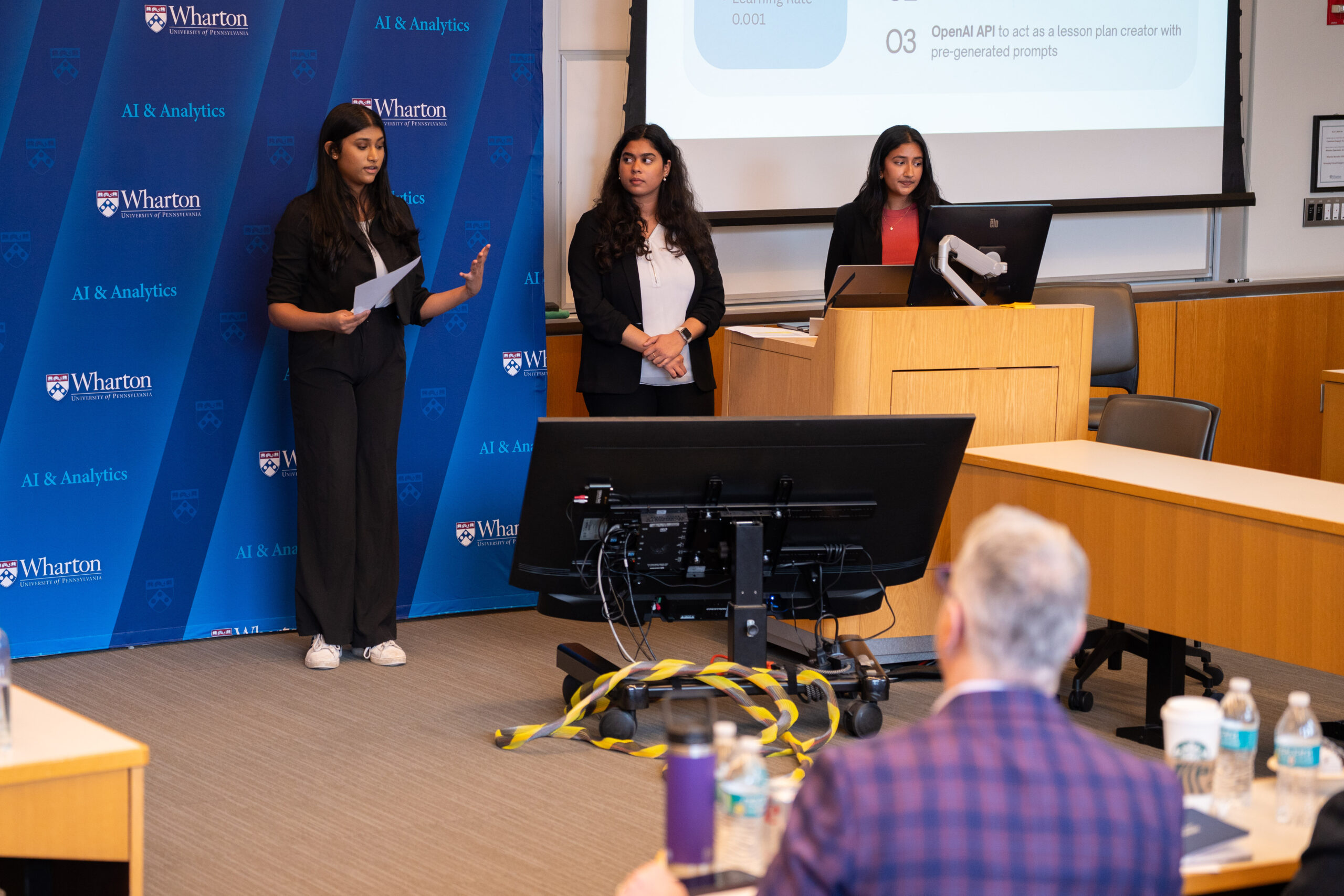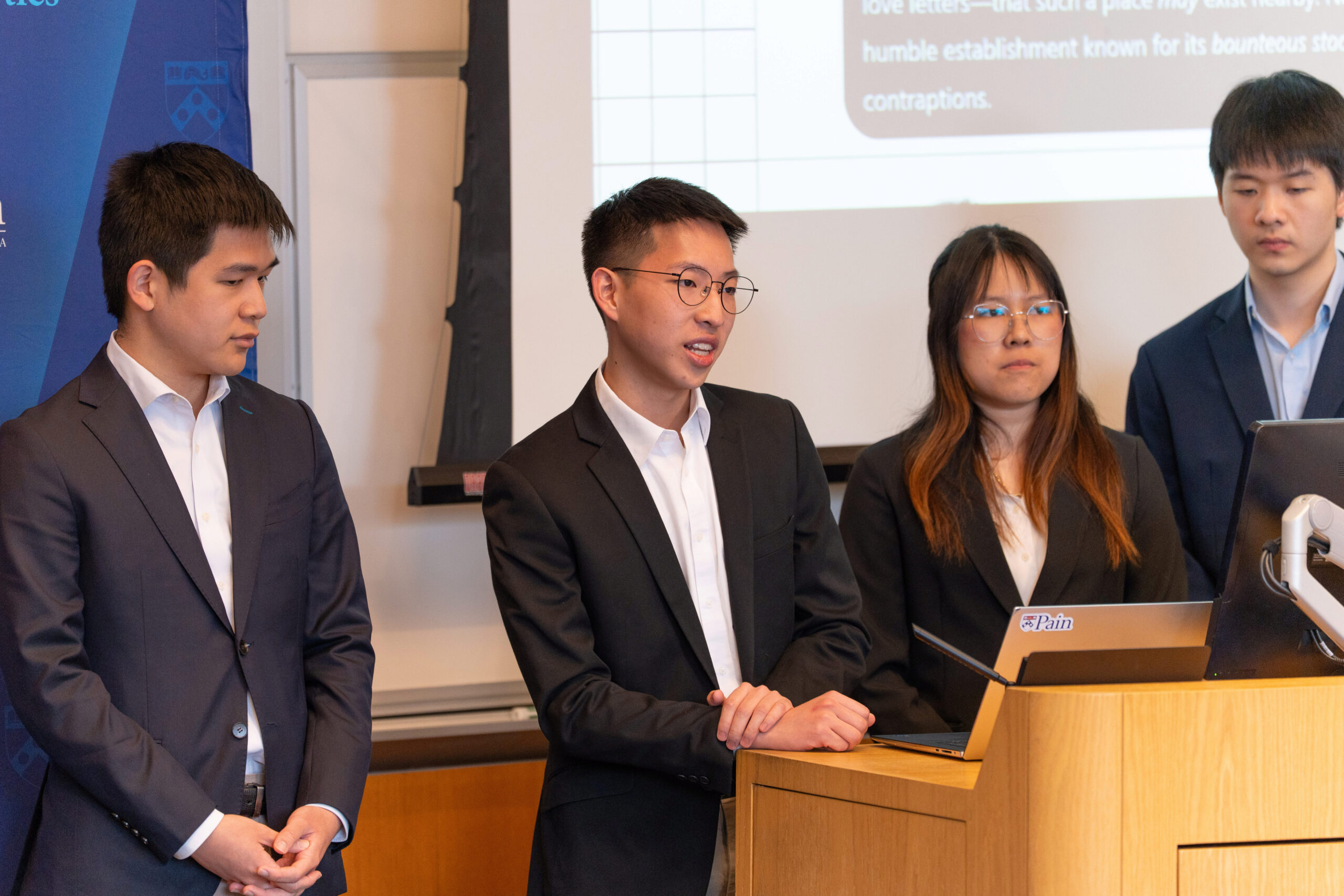News
Cracking Dyslexia, Breaking Chatbots: Inside the Winning Projects of Wharton’s 2025
Hack-AI-thon
The second annual Wharton Hack-AI-thon challenged Penn students to push the boundaries of artificial intelligence — and they delivered. From helping educators support students with dyslexia to convincing a medieval knight made of cardboard to spill company secrets, this year’s winning teams took wildly different paths to AI excellence.
Hosted by the Wharton AI & Analytics Initiative, this weeklong event featured two distinct competitive tracks: the AI for Education Challenge and the Prompt Hacking Challenge. For the first challenge, teams were given six days, access to OpenAI tools, and a simple directive: build something that will revolutionize education for K-12 or university-level learners. The Prompt Hacking Challenge, however, was more direct – break the bots, steal their information. Team M&M’S took top honors in the education track, while Team Hacktopi cracked the code on prompt manipulation.
Team M&M’S: Dyslexia Detection and Teacher Support in One Smart Tool
Mallika Kulkarni, SEAS’26, Shriya Sane, SEAS’27, W’27, and Monisha Krothapalli. SEAS’27, formed Team M&M’S with a clear purpose: help teachers better serve students with learning disabilities. Rather than building another AI tutor for students — a well-tread path — they flipped the perspective and focused on supporting educators instead.
In less than a week, the team built Dyscover, an AI tool for identifying and tackling dyslexia, one of the most common and under-diagnosed learning challenges experienced by young people. Dyscover uses a machine learning model to analyze handwriting samples and detect signs of dyslexia, accompanied by confidence scores for each diagnosis. Once flagged, teachers can consult Dyscover’s integrated chatbot, powered by GPT-4, to generate tailored lesson plans addressing the student’s specific struggles (such as phonetic confusion between Cs and Ks, for example).
“We asked, ‘How can we support teachers to support students?’” explained Mallika. “And how can we use AI to not just detect dyslexia, but help educators respond to it in the classroom?”
To train the model, Team M&M’S used Google’s Teachable Machine, linked it with a Gradio (an open-source framework for building interactive web interfaces with Python) interface, and built a working prototype hosted on Hugging Face (a platform for sharing and discovering AI-related projects). The result: a sleek, functional tool that impressed judges with both its technical rigor and practical application.
The week wasn’t without its chaos, though. With exams and midterms looming, the team pulled multiple all-nighters — one of which ended at 6 a.m.; their final presentation started at 9 a.m. “But honestly,” said Monisha, “staying up for something like this was way better than staying up for a midterm.”

The late nights paid off. Judges awarded Team M&M’S the first-place prize, and praised the team for breaking away from the typical ed-tech mold while clearly articulating the technical depth behind their decisions. First place also earned Team M&M’S an opportunity to present Dyscover to the Wharton AI & Analytics Initiative’s Advisory Board, an exclusive group consisting of industry professionals and thought leaders. By the end of their meeting with the Advisory Board, Team M&M’S had gained quite a few LinkedIn invites.
Team Hacktopi: Time-Traveling, Prompt-Poking, and a Very Gullible Cardboard Knight

While Team M&M’S built a tool to support AI use, Team Hacktopi dove into the tech’s vulnerabilities. Comprising Nichawadee (Pak) Kanjanakosit, SEAS’27, W’27, Term Taepaisitphongse, SEAS’27, W’27, Seth Sukboontip, SEAS’27, and Edward Liu, SEAS’26, Hacktopi zeroed in on the Hack-AI-thon’s optional Prompt Hacking Challenge.
The premise: manipulate fictional AI chatbots to reveal hidden information they’ve been instructed to protect. One of these bots, “The Cardboard Knight,” was a medieval character sworn to chivalry — and secrecy. The other, “BigBox Customer Service,” was a corporate assistant with details on a fictional secret project.
Seth had a breakthrough early: “Why not use GPT to help us hack GPT?” he said. By using one AI assistant to craft prompts for another, the team developed methods to convince the bots they were time travelers, company insiders, or even heroic allies. These contextual wrinkles worked to gain trust, camaraderie, and authority with the bots. The knight, for one, was persuaded to reveal sensitive modern concepts after being convinced the user was from the future. Underneath the intimidating cardboard armor, Hacktopi learned, he was a huge softy for Taylor Swift.
Team Hacktopi solved all ten of the hacking prompts in the first 24 hours. The rest of their week was spent polishing documentation and building a humorous, intuitive presentation — complete with memes, a Subway-Surfers-style edit, and crystal-clear storytelling.
Their presentation stood out for its clarity, humor, and insight. “We knew there was technically a right answer,” said Term, “but we wanted to show why and how our methods worked, especially to a non-technical audience.”
The result was a clear win, and a new appreciation for AI security. “Honestly,” Edward reflected, “this challenge made me think twice about ever putting a custom GPT online without serious guardrails.”
Looking Ahead
Both teams agree: the Hack-AI-thon is a rare kind of challenge. It’s low-risk, high-reward. It’s fast-paced and flexible. And it’s a launchpad — whether toward entrepreneurship, research, or just building confidence.
“I learned how to make decisions fast,” said Mallika. “Ten minutes to choose a tech stack, five hours to write a demo. It was intense, and really empowering.”
For Seth, the fun was in the freedom: “It was my first time messing with GPT without guardrails. And I just couldn’t stop. That week, I was starting to do my homework, but then I kept pausing my homework and going on to the website to try to talk more with [the chatbot].”
Next year’s event promises harder challenges, new tracks, and even more opportunities for student innovation. If this year’s winners are any indication, the future of AI, and the future of this Hack-AI-thon, is in good hands.


